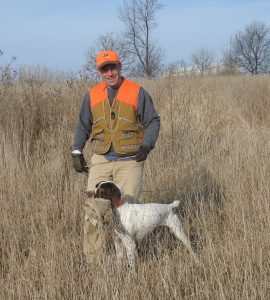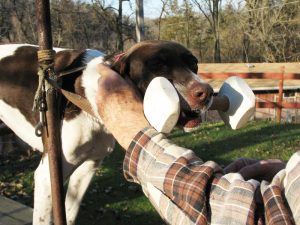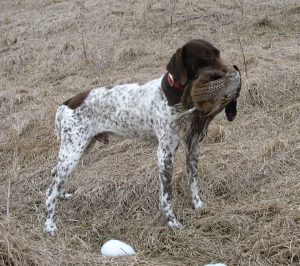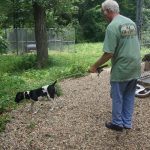Hard Mouth: Is There a Cure?
Pointing Dog Pointer
by Bob and Jody Iler
 In training a young pointing dog, some problems can surface quickly and decisively, leaving no room for doubt when you encounter them. “Hard mouth” is one of them. Whether you’re interested in a having a good hunting dog or plan to compete in field events, or both, hard mouth can be a troublesome problem. The hard-mouthed dog can crush birds, chew them up beyond recognition, even eat them. He or she can render the birds unfit for eating and be disqualified for this behavior in field events.
In training a young pointing dog, some problems can surface quickly and decisively, leaving no room for doubt when you encounter them. “Hard mouth” is one of them. Whether you’re interested in a having a good hunting dog or plan to compete in field events, or both, hard mouth can be a troublesome problem. The hard-mouthed dog can crush birds, chew them up beyond recognition, even eat them. He or she can render the birds unfit for eating and be disqualified for this behavior in field events.
Early on, you may notice that your pup lunges out and grabs a bird with gusto. This in itself isn’t a bad thing—we like to see this enthusiasm for birds. But as your pup gets bigger, he may start to clamp down too hard on the bird. He may refuse to give up the bird to you, grinding down on it even harder. He may also start to chomp on the bird—which brings to mind a dog we once had at our kennel for training that was aptly named “Chomp”—for doing exactly that. And, horror of horrors, your dog may even eat the bird. And yes, we once trained a great bird dog that chose to eat the quail she was supposed to retrieve, right in front of her visiting owner!
If any of these scenarios describe your dog, your heart is probably sinking right about now. But don’t despair just yet. There are some things you can do to remedy or alleviate the problem. And if your pup is still quite young, take note here that it’s not a good idea to play tug of war with your puppy, teaching him aggressive behavior using his mouth. Retrieving “games” where your pup refuses to give up the dummy or ball to you can result in hard mouth tendencies too.
Hard mouth, like other behaviors, is often an inherited trait. If the problem is not addressed, it generally will worsen and certainly not go away by itself.
When pups with hard mouth are introduced to birds, the more the bird flaps around and doesn’t fly off, the more excited this pup will get, and the more he’ll want to grab the bird. If a pheasant spurs a youngster with this trait, it may cause the dog to clamp down hard on the bird. Proper bird introduction with plenty of flyaway birds (that the dog can’t catch) and training the dog to retrieve properly can help reduce the likelihood of dogs becoming hard-mouthed. In retrieve training, we snug the bird in a sock with an opening on one end for its head, or wrap or tie the wings and legs to keep the bird immobile and the dog less likely to want to clamp down hard on it.
 Many “old-time” solutions that you may have heard about involve things like wrapping dummies in barbed wire, using bristly brushes as retrieve objects, and so on. Sometimes the e-collar is also used to address this problem. This can be a slippery slope, because if the dog associates the e-collar correction with the act of holding a bird in his mouth, it may result in the dog never picking up a bird again!
Many “old-time” solutions that you may have heard about involve things like wrapping dummies in barbed wire, using bristly brushes as retrieve objects, and so on. Sometimes the e-collar is also used to address this problem. This can be a slippery slope, because if the dog associates the e-collar correction with the act of holding a bird in his mouth, it may result in the dog never picking up a bird again!
You can test your young dog out using the wrapped or trussed up bird described above. Put your pup on a long checkcord and toss the bird out into the grass. As pup runs out to grab it, watch him closely. As soon as he picks up the bird, have enough tension in the checkcord that you can use it to hustle him quickly back to you as you repeat “easy, easy.”
Keeping him moving will make him less able to mouth, chew or chomp on the bird. Try to focus his mind on bringing the bird back to you so you can praise him and hopefully, take the bird away from him as gently as possible. You may have to tuck his “flews” (lips) over his teeth on both sides of his upper jaw with one hand while you remove the bird with the other. Do not make this an issue. Firmly say “No!” if he’s clamping down hard on the bird, and then say “Out!” as you remove the bird as quickly and matter-of-factly as possible. Don’t forget to praise him if he releases the bird.
Vary the routine by reeling the dog back to you with the bird as fast as possible and then, instead of immediately taking the bird away from the dog, shorten the checkcord to heeling length as you take a short walk around, letting him carry the bird as he walks by your side. Don’t stop; keep moving and don’t give him a chance to mouth, chew or chomp on the bird. Eventually, if you can walk your dog along without him squeezing or killing the bird while heeling you’re making good progress.
 The trained retrieve program can help with the problem of hard mouth. For the most in-depth description of how to do this, you can check the 2001 back issues of The Pointing Dog Journal (March/April and May/June) for our articles: “The Trained Retrieve—Parts One and Two.” The “Hold” command will teach your dog to properly hold the object or bird without chomping or chewing on it, and the “Out” command will teach the dog to release the bird to you on command.
The trained retrieve program can help with the problem of hard mouth. For the most in-depth description of how to do this, you can check the 2001 back issues of The Pointing Dog Journal (March/April and May/June) for our articles: “The Trained Retrieve—Parts One and Two.” The “Hold” command will teach your dog to properly hold the object or bird without chomping or chewing on it, and the “Out” command will teach the dog to release the bird to you on command.
Natural retrievers are a joy to own! But the natural retriever may also prove to be hard-mouthed or, on the flip side, he may gently carry the birds without ever damaging them. As you watch your young dog bound out to retrieve the bird, you’ll soon find out how he’s going to handle the situation. The natural retriever will be enthused and want to pick up the bird and run around with it in his mouth, proud and excited. The hard-mouthed dog will run out, just as excited, but will often stand over the bird, mouthing or chewing it, or worse, chomping down on or eating it. Hard-mouthed dogs tend to stay with the bird and decimate it, rather than picking it up and carrying it. We once had a dog at our kennel for field training that disemboweled the downed pheasant before we could even get to the dog and bird.
Hard mouth and uneatable birds are, no doubt, a big problem that may or may not be able to be remedied. We’ve had the best results by using our trained retrieve program, but don’t be afraid to try other solutions as long as they are not detrimental to the dog. Unfortunately, sometimes the hard-mouthed dog will always remain so, but may possibly be brought up to the level of not mangling the bird through training.
We had a female German shorthair pointer some years back that had this problem. She liked to mouth and chew the bird, shaking it and flipping it around. She took to the trained retrieve program well, and learned to fetch, hold and release the bird, reliably and on command. But for all of her days as our personal hunting dog, if the bird she picked up in the field was still alive, she exerted pressure on it until she killed it.
Don’t be discouraged; you can often achieve a measure of success with this problem by keeping at it with diligence, patience and time!
Pointing Dog Pointers features monthly training tips by Bob and Jody Iler, who own Green Valley Kennels in Dubuque, Iowa. Bob and Jody have trained pointing dogs for over 35 years and have written many articles for Pointing Dog Journal.




